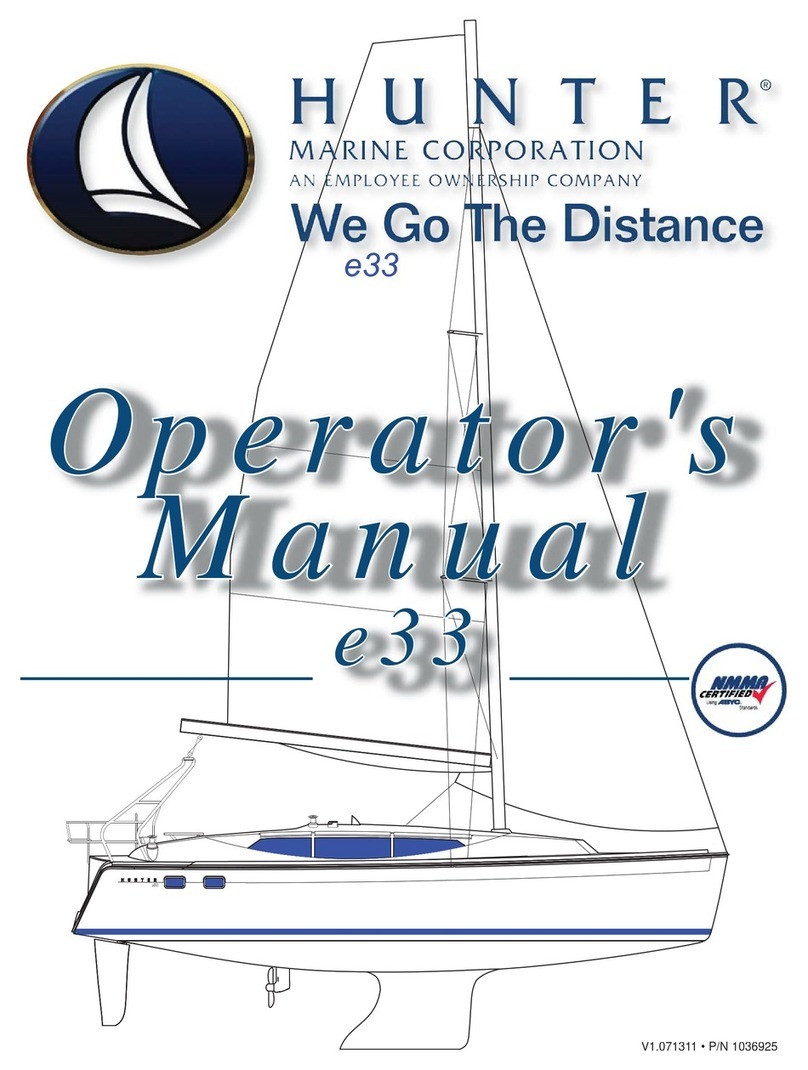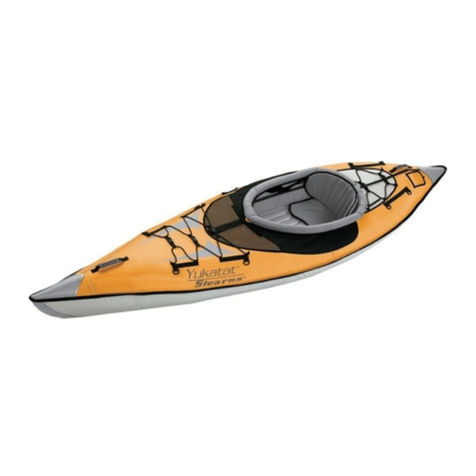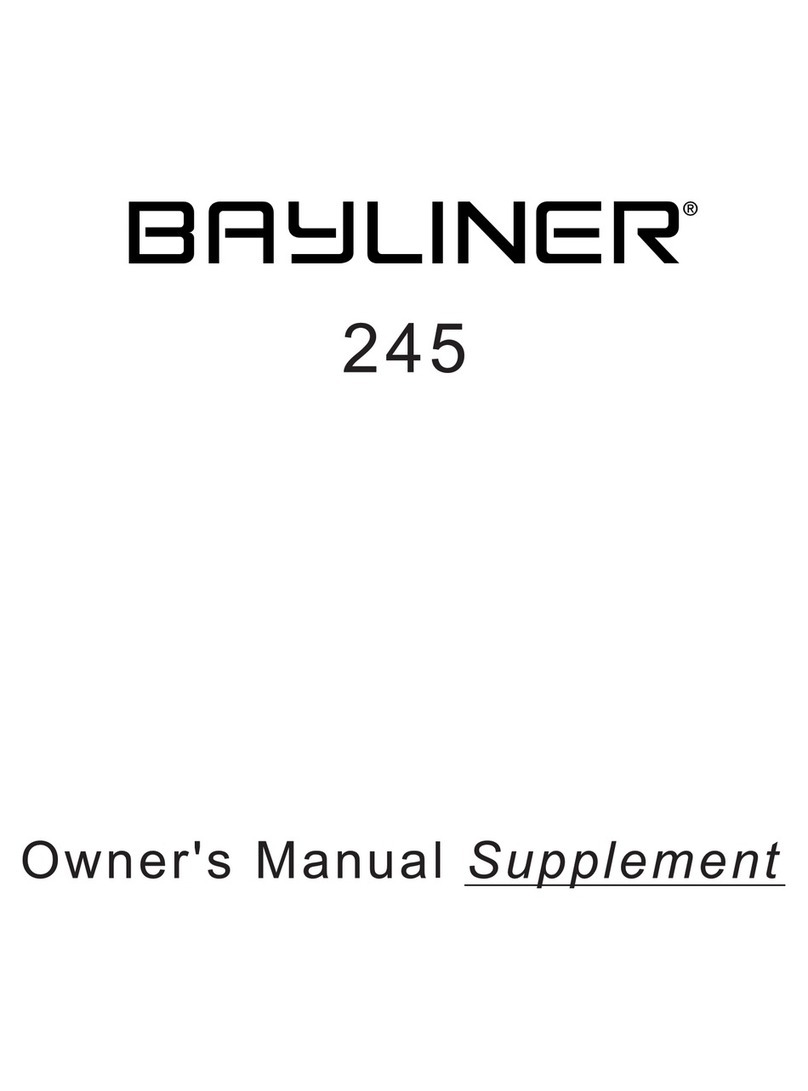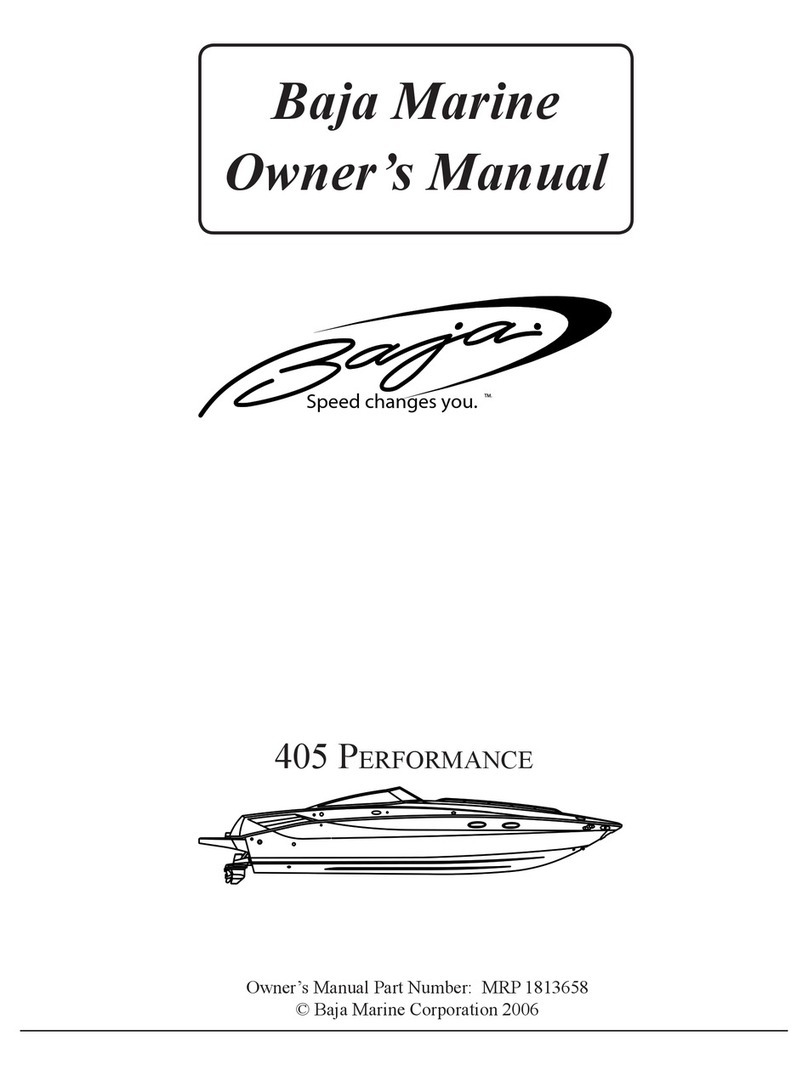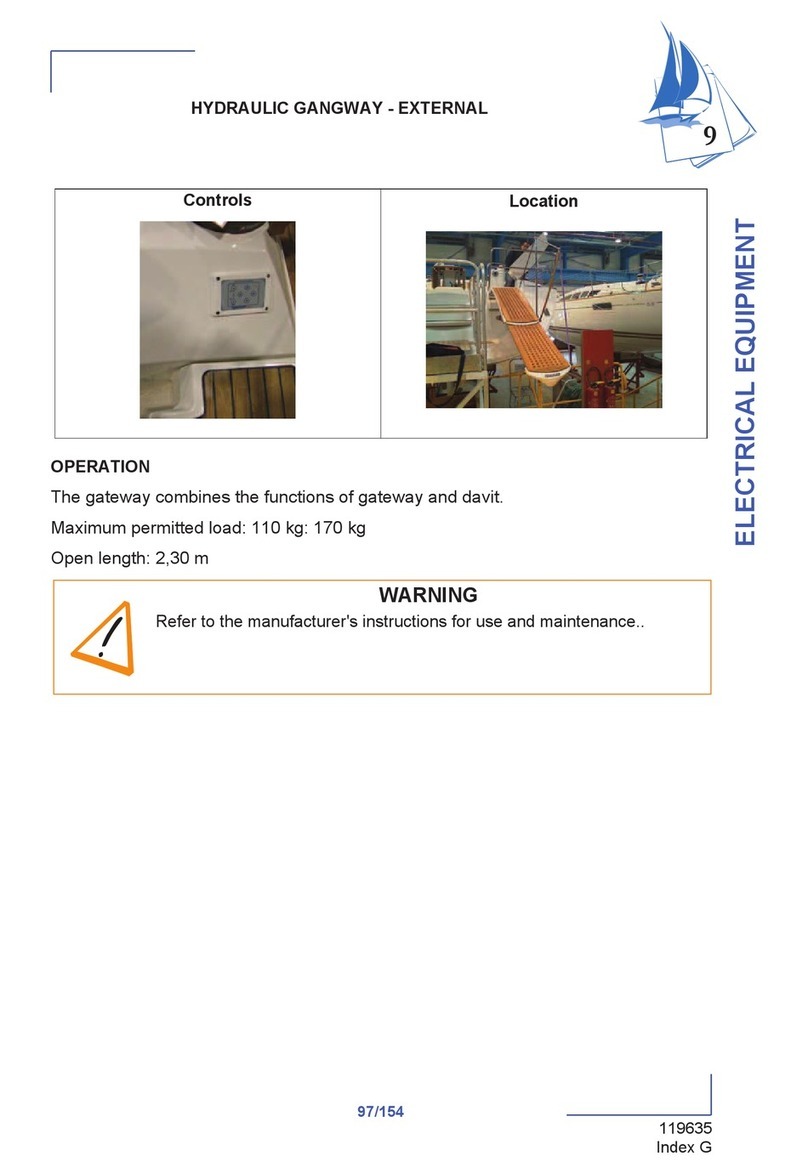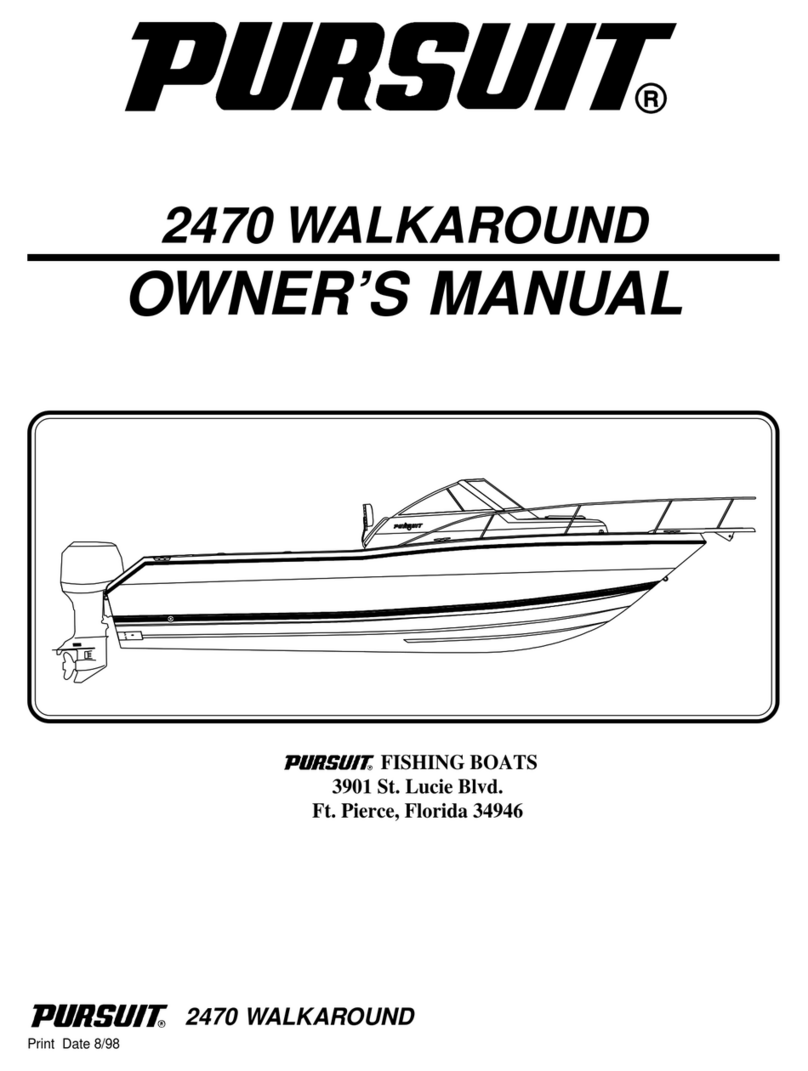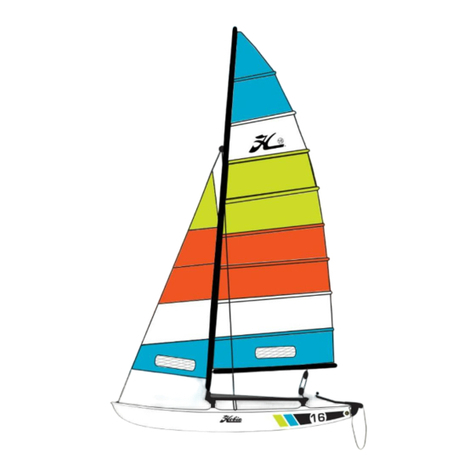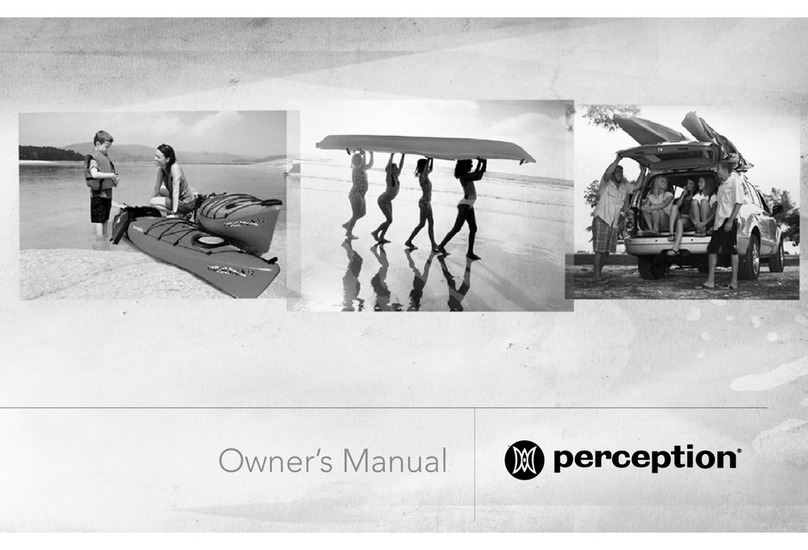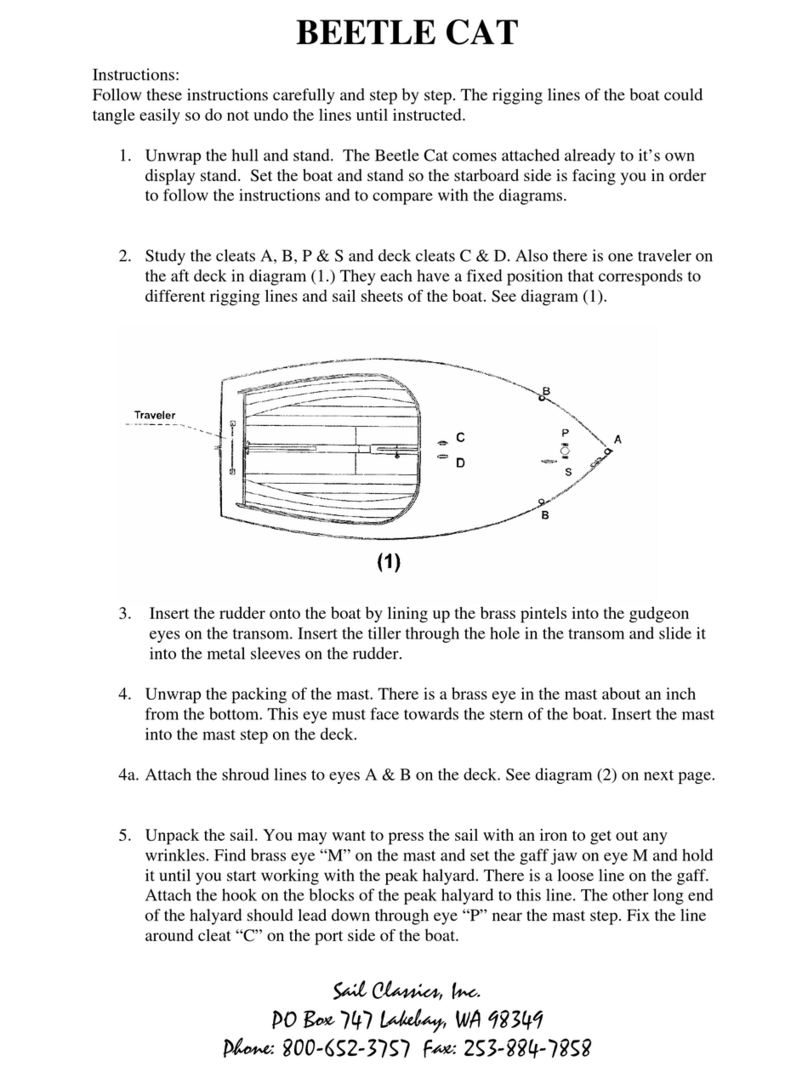Rondar Raceboats Limited VIPER 640 User manual

VIPER
640
OWNER’S MANUAL
Rondar Raceboats Limited
5 STATION YARD, EDINGTON, WESTBURY, WILTSHRE, BA13 4NT.
Tel. +44(0)1380 831138 Fax. +44 (0) 1380 831444

WWW.RONDARBOATS.COM
INTRODUCTION
Congratulations on the purchase of your new Viper and thank you for
choosing our boat. We are confident that you will have many hours of great
sailing and racing in this truly excellent design. The Viper is an exciting boat to
sail and offers fantastic performance. It is a lightweight racing boat and should be
treated with care. In order to get the most enjoyment from your boat and maintain it
in top condition, please read this manual carefully.
Whilst your boat has been carefully prepared prior to shipment, it is important that
new owners should check that shackles, knots and mast step bolts etc. are tight. This
is especially important when the boat is new, as travelling can loosen seemingly tight
fittings and knots. It is also important to regularly check such items prior to sailing.
Make sure that you have a basic tool kit with you the first time you rig the boat in
case there are tuning / settings changes that you wish to make.
FOR THE FIRST TIME YOU GO AFLOAT……….
When launching and sailing your Viper for the first time, please remember the
following points:
• New boats are covered in an invisible layer of mould release wax, and silicone
release agents, in order to get them out of the moulds. They are also cleaned and
polished as part of the pre-delivery inspection process. The first few times that you
sail your new boat you should take extra care as it will be slippery and potentially
dangerous until these coatings wear off.
• Ropes are also coated in release agents as part of their construction process, so
again, take great care when tying knots or relying on lines to perform a specific
function, as they may undo themselves and get you into a potentially dangerous
situation.
• After sailing the boat for the first few times, take a wrench and screwdriver and
check the tightness of all the major fittings (double check highly loaded fittings.)
• When lowering the keel for the first few times the packing may be a little tight, it
tends to wear a little and is designed as a replaceable part. If necessary, spray a
little McLube or similar lubricant onto the keel blade, as required, to make lowering
and raising the keel easier.
• Last but not least, your boat has been designed to be easy to operate. If you find
yourself needing to use excessive force, or tools such as hammers, then you are
probably doing it wrong. It would be a good idea to stop and re-evaluate the situation.
A quick phone call to the factory or your local rep could solve the problem much more
easily…
Now, apologies to all the highly experienced, race winning and world champion
yachtsmen amongst you for this last piece of advice! New boats always take some
getting used to. If it is blowing the dog off his lead, and the waves are dumping on the
beach, why not curb that impatience to get afloat in your new boat. If the conditions
are favourable, the chances are that you’ll have far more fun and learn the
techniques used on the Viper much more quickly.

For further information, spares and accessories, please contact your local
dealer, or Rondar Raceboats Limited direct.
Your Viper has been supplied by:
RIGGING INSTRUCTIONS
1. Rigging the mast from new involves fitting the two halves together and
ensuring that the halyards are not twisted. This is very important to ensure
smooth running of the halyards
2. Fit the spreaders by bolting them through the appropriate holes in the
brackets. The outer one goes through the aft hole in the bracket, and the
inner end is positioned as far forwards as possible.

3. Once fitted correctly the excess bolt length should be cut off, and the ends
filed smooth to prevent the spinnaker ripping on any jagged cut metal. It’s
always a good idea to wrap all of the potential snags the spinnaker may come
in contact with using a little rigging or white electrical tape.
4. The standing rigging can then be fitted to the mast by inserting the upper
ends (T Balls) into the Terminal sockets, and attaching the upper shrouds to
the end of the spreaders using the clevis pins. Leave two holes showing on
the spreader tip (pin through the third hole).
5. Take the dyneema keel hoist line and shackle it to the tang on the port side of
the spreader bracket. Attach any wind indicators or similar to the head.

6. Measure the forestay BS to BS (Bearing Surface to Bearing Surface) and lock
off the adjuster at 24ft 6”. Undo the upper shrouds turnbuckles to maximum
open.
Stepping the mast
1). Ensure that the halyards are positioned so the free ends can be reached once
the mast has been stepped.
2). Carry the mast to the rear of the boat, butt end into the cockpit. Best to keep
the boat attached to the car to prevent the boat and trailer from tipping onto
the stern when you are climbing aboard the rear of the boat. Usually one
person can carry the rig alone but for the first few times, use two people until
you get accustomed to moving the mast solely. You will place one person at
the front of the boat to move the headstay onto the stem fitting and attach it
with the clevis pin and split ring.
3). Using a small piece of line (or use a pair of Cunningham hooks measured to
fit) tie the mast butt (lower end) to the forward most padeye, just forward of
the keel. This allows you to pivot the mast on its butt without having it slide
forward into the boat. Simply hand over hand stand up the mast inside boat,
adjacent to the mast gate. One person should stand in the boat and lift the
mast into place, taking care when lowering it through the gate in the deck and
down into the mast step. Ensure the heel is properly located in the mast step.
It helps to ensure that the mast step is clear of ropes before you start to lift
the mast into position, and that the deck control rope is loosened off. When
stepped, visually check that the T terminals have not become jammed into the
wrong positions when stepping.
4). Attach the forestay to the aft hole in the stem fitting, as above described,
securing it with clevis pin and split ring. This should be taped, as the
spinnaker will contact this frequently. You can then let mast lean aft. The
forestay will keep it from falling aft and the mast partners will stop it from
falling side to side.
5). Attach the main shrouds to the large aft chain plates. Take up some slack on
the turnbuckles.
6). Assuming the forestay is pre set to 24ft 6”, then harden down the shrouds
until you have about 4 to 5” of prebend in the mast measured between the
back of the mast at the spreader bracket, and the straight line between the tip
of the mast and the back of the mast at deck level. This will equate to around
32 on a LOOS gauge measured at the upper shroud. Check the mast is set
symmetrically by taking the jib halyard down to each chain plate, and
equalising the shroud tensions until the mast is symmetrical (even, side to
side)
7). Connect the lower shrouds via the multi hole adjuster to the main shroud
plates. They should be hand tight only at this point
8). Thread the mast gate control line around the front of the mast, through the
block, back around the front of the mast, pull it tight enough to limit forward
mast movement and jamb it in the cleat.
Rigging the jib
9). Tie or shackle the tack of the jib to the aft hole of the bow fitting. Tape the
shackle to stop the spinnaker ripping on it when hoisting or lowering the sail.

10). Tie the halyard on to the head of the sail. Thread the jib sheet through the
clew blocks on the sail. Attach the luff of the sail to the forestay using the clip
on hanks.
11). Thread the lower end of the jib halyard through the double block on the fine
tune system under the foredeck, and then up through the port side deck
block, and cleat.
12). Hoist the jib by pulling the halyard up through the deck cleat. You will need to
ensure that the jib sheet is slack. Do not over tighten the jib halyard, you will
need the travel on the fine tune system
13). Tension the luff using the 4:1 fine tune positioned under the foredeck.
How to tune the mast before sailing.
Once the jib is hoisted and the rig tensioned, you should check the rig settings as
rigging lengths can vary and the shroud settings indicated above only give a
guideline. A good sailing tension is 150 – 180 kg (285 - 400 lbs) measured on the jib
luff wire. This is a lot of tension and will require quite a strong pull on the tension
system rope.
There should be at least 110mm (4.33”) of pre bend, which is controlled in the main
part of the mast by the upper shroud tension. Note, the spreaders are positioned
in a “safe” setting. Alterations are made at the owner’s risk – moving the
spreaders to extreme forward settings may result in rig failure by the mast
inverting downwind with the spinnaker up.
The mast should look like this when correctly tensioned.

The lower shrouds should allow the lower part of the mast to pre-bend. They should
not carry much tension until the mainsail has been hoisted and the gnav attached.
The lowers shrouds merely prevent excessive bend from the vang in the lower part of
the mast. Reduce tension in the lowers if they stop the mast from assuming a natural
curve from the pre-bend caused by the spreaders. Note that too much tension in
the lowers will encourage the mast to invert downwind, and this can lead to
mast failure.
NOTE: The very first time you apply rig tension, you may hear some settlement
noise from the rig and hull (odd creaks, cracks, groans, etc.!). This is quite
natural and is because all of the separate components are “bedding in” and
stretching or moving to their normal tensioned positions. After the first few
sails, so long as you stay within the parameters described above, this will stop.
Rigging the asymmetric spinnaker (add a series of photos???)
14). Thread the spinnaker halyard in the following order:
From the mast, down through the block on the deck to starboard side of the
mast step, and aft through the block at the rear of the keel case recess, and
then through the aft block at the end of the sock, and up through the sock to
the bow.
15). Attach the spinnaker as follows:
Tie the line from the forward end of the bowsprit to the tack of the spinnaker.

To ensure that the sail is not twisted, run your hands up the red luff tape on
the spinnaker until you reach the head of the sail, then tie the spinnaker
halyard on to the head of the sail.
Tie the middle of the spinnaker sheets to the clew of the sail. Lead the ends
through the blocks amidships on the gunwhales, and then forwards to the
ratchet blocks near the shroud plates (ensure you thread it the correct way
through the ratchets, which only work under load), and tie the ends together.
The spinnaker halyard tail (spinnaker downhaul) comes from the chute
mouth, leads through a loop on the lower third of the spinnaker and ties onto
the webbing strop on the top third of the sail. It is a good idea to tie it on with
a long loop, say 300 mm (12”) here, as it makes the spinnaker enter the chute
more easily when dropping.
The safest and easiest way to rig the downhaul is to pull the pole right out,
and to pull the port sheet tight into the ratchet and to cleat it off. If you then
hoist the spinnaker until the head is about 2 metres off the ground you can
then see the two attachment points on the spinnaker. You can then thread the
spinnaker downhaul under the foot of the sail and sheets, up through the
lower ring, and tie it to the top loop.
16). You can then pull the spinnaker into the chute by pulling on the downhaul
at the block just aft of the spinnaker sock. If the spinnaker will not stow away
completely, then check that the halyards and the sheets are un-cleated.
Rigging the mainsail
17). Slip the clew strap around the aft end of the boom.
18). Thread the outhaul through the clew eye and hook the end into the slot on the
end of the boom.
19). Ensure the boat is head to wind. Tie the main halyard to the head of the sail
with a VERY short bowline or a dinghy hitch and hoist the mainsail. Pull the
halyard tight through the cleat to ensure all slack is removed and the main is
fully hoisted. Make CERTAIN you do not hoist the main halyard slipping
through the cleats as this only wears them down limiting their holding power.
Place the halyard next to the cleats to hoist then simply slide it into the cleats
once the halyard is FULLY hoisted.
20). Fit the boom onto the gooseneck, and fit the two webbing tack straps around
mast. Tension the outhaul to sailing position.
21). Thread the cunningham line through the cringle above the tack and tie the
end around the gooseneck fitting.
22) Attach the gnav upper strut to the upper mounting post, and fit the gooseneck
retaining pin to prevent boom pulling off.
Rudder
23). The rudder blade simply slots into the transom gudgeon AFTER launching
(prevents rudder damage) and has a retaining clip to prevent accidental
dislodging. It is sensible to also tie the rudder on in case of accidental
removal, during a capsize for example

Launching
Individual launching areas vary and common sense will determine the best order of
proceedings when launching the Viper. The boat launches from its trolley just like a
dinghy, and can be launched from a crane hoist, slipway, shore or beach with ease.
The boat will sail with just 0.5 metres (20”) of keel down, and although it is less stable
in this mode, it will not capsize.
Option 1. The favourite option is to launch the boat from a crane or slipway, with a
convenient dock nearby. Put the boat in the water once the jib and spinnaker have
been rigged. Tie it head to wind to a dock or mooring, lower the keel and then hoist
the mainsail.
Option 2. If option 1 is not possible, rig the jib and spinnaker, launch the boat, walk it
into deep enough water to lower the keel half down, sail the boat off under jib alone,
then drop the keel and hoist the mainsail in deeper water.
IMPORTANT
When you are ready to launch, ensure that the keel hoist purchase is securely
cleated. When craning in , double tie the loose end to avoid the keel suddenly
dropping in mid air.
Always ensure the keel lift purchase blocks are not “eased” and that there is
no slack or any “loops” caught in the purchase that may pull out and allow the
keel to drop unexpectedly.
Keep your fingers and feet and all ropes and controls away from the keel slot
and the top of the capping until the keel is fully lowered.
The boat will feel less than stable until the keel has been lowered at least half
way down.
24). Once the keel is almost fully lowered, you will need to guide it onto the
mounts, using the hoist purchase to swing it into position. Then un-hook the
keel hoist line and stow it in the side locker.
25). Fit the retaining bolts to the keel before leaving the dock.
NOTE: The keel must ALWAYS be secured in place with the keel hold down
bolts prior to sailing the boat fully.
When bringing the boat ashore, reverse the above process. Lower the keel back onto
the trolley cradle as soon as practical to reduce the loading on the rig.
TUNING AND SAILING TIPS
Keel
The keel should be left fully down while sailing. Only lift the keel for launch and
recovery, or in the event of grounding.
Cunningham or Downhaul
Increasing the tension progressively bends the mast, flattens the sail and opens the
leech. In lighter airs keep it fairly slack and progressively increase the tension up the

wind range. Extreme tension should blade the upper leech out flat in very strong
conditions.
GNAV Kicker (Vang spelled backwards)
The more wind there is, the more gnav you need. It powers up the leech helping
pointing upwind and maintaining power on the reaches. In very gusty conditions,
easing it will make the rig more forgiving. Ease it down wind, prior to bearing away.
Jib sheeting
To tighten the jib leech, move the jib track cars forwards and vice versa to loosen it.
Tacking
For best speed out of the tack ease the sheet about 150mm (6”) as you go through
the tack and then tighten it again when the boat has accelerated on the new tack.
Spinnaker hoist
The spinnaker halyard is led so that either the helm or the crew can hoist and drop
the sail.
First, ensure the spinnaker sheets are not cleated. Bear the boat away on to a run
(this is not necessary in very light winds). The forward crew should pull the pole out
first, or simultaneously with the middleman hoisting the spinnaker. Do not sail for long
with the pole out prior to hoisting. The sail could catch in the water and drag the
whole sail out of the chute and under the boat.
Gybing
Always gybe with the boat sailing as fast as possible. In breezy conditions the
helmsman should steer back into the gybe as the boom comes across, so that the
boat is travelling straight downwind as the sails fill on the new side.
Spinnaker drop
Bear away onto a run (again, this is not necessary in light winds). The crew should
release the pole outhaul and the spinnaker halyard. The middleman or the helmsman
can then drop the sail retrieving it into the chute with the dousing line (other end of
the spinnaker halyard). As the sail is pulled into the chute, the bowsprit will
automatically be pulled back into the boat.
Downwind sailing
The Viper has a lightweight and high performance rig. In breezy conditions it is
essential to “look after” for your rig downwind by adhering to the following points:
•Make sure you have sufficient rig tension applied (remember rigging stretches).
•Make sure you have a sufficient mast rake
•Make sure the spreaders and lowers give at least 110mm(4.33”) of pre bend to
the mast.
•Make sure the deck level bend control is not over tight – let it right off, then pull
on firmly again.
•Put a stopper knot in the mainsheet so that the boom cannot touch the shrouds.
(We suggest you tie the knot to stop the boom, 6- 8” from the shrouds)
•Keep the cunningham on tight downwind, to help lock in the pre bend.
•Keep the boom sheeted in as far as possible (there is not normally much load on
the mainsheet due to the apparent wind moving forward), so that the leech holds
the top of the mast back. The leach of the main acts as your backstay on the
Viper.

CARE AND MAINTENANCE
Hull
The Viper is made using a GRP foam sandwich laminate. This is stiff and light, but
will dent if subjected to point loading. The boat should be supported ashore on a
factory supplied Viper dolly or trailer.
Keep your boat drained and well ventilated
Obviously in dealing with a marine environment, equipment gets wet, which in itself is
not a problem. The problem starts when moisture is trapped for any length of time.
The key, therefore, is to store the boat properly ashore. Water absorption could
cause blistering and a raised fibre pattern.
a) Ensure the boat is kept at an angle to allow water to drain away.
b) If leaving a cover on the boat, ensure that the transom is open and down for
drainage.
Wash with fresh water
Fresh water evaporates far more quickly than salt water, so if your Viper has been
sailed in salt water wash it off thoroughly. The fittings will also work better if regularly
rinsed.
Damage
Hull damage falls into three categories:
a) SERIOUS e.g. A large hole, split, crack or worse. Get the boat back to your
nearest dealer – don’t be too distressed! Most problems can be repaired by an
expert.
b) MEDIUM e.g. Small hole or split, gel crazing. If this occurs during an event,
sailing can often be continued as long as drying the area and applying a strong
adhesive tape prevents any leaks. CAUTION – if the damage is close to a heavily
loaded point then a close examination should be made to ensure joints and the
laminate are fit for the prevailing conditions. Get the damage properly repaired as
soon as possible.
c) SMALL e.g. chips, scratching. This type of damage is not life threatening,
particularly as the boat is built using epoxy resin, and therefore allows virtually no
water absorption into the laminate. The owner, using the correct gel coat, can
repair this type of damage.

Tying down
Tying down your Viper to its trailer is important because too much or too little tension
could result in damage. Only use an approved dolly or trailer. The boat is well located
on its dolly, so you only need apply sufficient tension to hold the boat in contact with
the supports.
Tie the boat down at the bow and across the middle in the region of the trailer
wheels. Pad the deck where the straps touch. Use the strap winch at the bow to hold
the bow tight. You will need to tie a small, double-looped line to attach the bow winch
to.
Foils
The foils are vinylester GRP with a foam core. Look after them as you do the hull.
Wash with fresh water regularly. Repair any chips as soon as possible using
polyester gel.
If you intend to travel a lot with the boat, then a padded rudder bag will be a
worthwhile investment.
Noisy Foils
The Viper foils are vinylester GRP for easy repair and maintenance, and are made
from precise moulds and tooling. However, vibration from the foils can occur from
time to time, and is impossible to eliminate completely in the quality control process.
Foil vibration usually occurs due to the eddying effect of water leaving the trailing
edge of the foil. To ease this effect, gently abrade the back edge of the foil (approx
25-35mm <1”> will suffice) from top to bottom with progressively finer grades of
sandpaper to ‘sharpen’ the trailing edge of the foil. A power sander is the quickest
method – it’s not an issue if you penetrate the gelcoat, but ensure the trailing edge is
fair along its length. You can also put a slight bevel on the trailing edge leaving no
more than 3mm (.1”) at the very thinnest part of the trailing edge. This often allows
for a cleaner exit of water flow, thusly reducing or eliminating foil vibration.
Spars
The mast, boom and bowsprit are carbon composite structures. Wash with fresh
water as often as possible. Check the sheave at the mast head, along with both jib
and spinnaker halyard sheaves for wear.
The mast is finished with a coat of two part polyurethane varnish. This protects the
laminate against UV degradation in sunlight. It is advisable to apply a new coat of
varnish once a year. Lightly sand the mast to help the new varnish bond to the old.
It is particularly important to avoid chafe to the spars when trailing, as with carbon
spars it is very easy to cause structural damage on long cross continent trips. Pull all
the halyards into the mast and use suitable padding to protect the spars whilst trailing

Sails
The main and jib should be rolled and stored dry, out of direct sunlight. Dry the
spinnaker, fold it and store in its bag.
When using a new sail for the first time, try to avoid extreme conditions because high
loads on a new sailcloth can diminish the racing life of the sail.
If your sail is stained in any way, try to remove it using normal detergent and warm
water. Do not attempt to launder the sail yourself.
Repairs should be temporarily made using sticky number cloth or sail repair tape and
then returned to the sailmaker for a professional repair. Watch out for wear and tear,
especially around batten pockets and the bolt rope.
Replacement sails can be ordered from your dealer, as can a full range of spares
and accessories.

VIPER CLASS ASSOCIATION
The Class Association is highly active and well established and well worth joining.
The Viper Racing Circuit is fast becoming the envy of the 20 foot sportboat world,
with great competition and a fantastic and friendly social life. Please note that you do
have to be an Association member in order to compete in class sanctioned events.
The Class Association also produces regular Newsletters, organizes training events
and hosts a highly popular forum at http://forumViper640.org
The International Viper 640 Class Association will be centred around the
Viper640.org website.
Please use this site as a point of reference for all your enquiries.
http:www.Viper640.org
Table of contents

